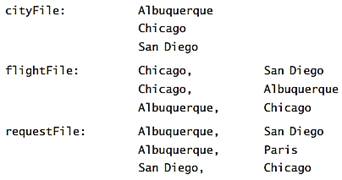Reference no: EM131076172
The HPAir problem was the subject of Programming Problems 11 through 14 of Chapter 6. Revise these problems by implementing the ADT flight map as a derived class of the graph class that you wrote for Programming Problem 3.
Programming Problem 3:
Repeat Programming Problems 1 and 2, but allow the graph to be either weighted or unweighted and either directed or undirected.
Programming Problems 1:
Write a C++ class derived from Graph Interface, as given in Listing 20-1. Use an adjacency matrix to represent the graph.
Programming Problems 2:
Repeat the previous programming problem, but represent the graph using an adjacency list instead of an adjacency matrix.
Chapter 6 Programming Problems 11:
Complete the solution to the HPAir problem. The input to the program consists of three text fi les, as follows:

You can make the following assumptions:
• Each city name contains at most 15 characters. Pairs of city names are separated by a comma.
• HPAir serves at most 20 cities.
• The input data is correct.
For example, the input fi les could appear as

For this input, the program should produce the following output:

Begin by implementing the ADT flight map as the C++ class Map. Use the stack version of is Path. Because get Next City is the primary operation that the search algorithm performs on the flight map, you should choose an implementation that will efficiently determine which cities are adjacent to a given city. If there are n cities numbered 1, 2, . . ., n, you can use n chains of linked nodes to represent the flight map. You place a node on list i for city j if and only if there is a directed path from city i to city j. Such a data structure is called an adjacency list; Figure 6-14 illustrates an adjacency list for the flight map in Figure 6-6. Chapter 20 discusses adjacency lists further when it presents ways to represent graphs. At that time, you will learn why an adjacency list is a good choice for the present program. To simplify reading the input text fi les, define a class that includes the following methods:

Chapter 6 Programming Problems 14:
What modifications to the previous programming problem are required to find a least-cost trip for each request? How can you incorporate time considerations into the problem?
|
Problem regarding the joint-cost function
: A company produces x units of commodity A and y units of commodity B each hour. The company can sell all of its units when commodity A sells for p=80-10x dollars per unit and commodity B sells for q=100-4y dollars per unit.
|
|
State cramer rule
: State Cramer's Rule. Use it to solve the linear system (no credit for solving the system directly)
|
|
Production quota for the total number of items
: A company manufactures x units of one item and y units of another. The total cost in dollars, C, of producing these two items is approximated by the function C=4x^2+3xy+6y^2+600. (a) If the production quota for the total number of items (both types..
|
|
Write six-ten facts or statistics you found interesting
: Write six-ten facts or statistics you found interesting. These facts should prove or disprove Martin Luther King's idea of the "promised land."
|
|
What modifications to the previous programming problem
: Write a C++ class derived from Graph Interface, as given in Listing 20-1. Use an adjacency matrix to represent the graph.
|
|
Production quota for the total number of items
: A company manufactures x units of one item and y units of another. The total cost in dollars, C, of producing these two items is approximated by the function C=4x^2+3xy+6y^2+600. (a) If the production quota for the total number of items (both types..
|
|
How did archetypes such as new woman come about in korea
: How did archetypes such as Good Wife Wise Mother, New Woman, and Modern Girl come about in Korea in the late 19th and early 20th centuries?
|
|
Use a statistical software package to construct
: Use a statistical software package to construct a normal probability plot of the tensile ultimate-strength data given in Exercise 13 of Chapter 1, and comment
|
|
Remaining apples and he also dozed back to sleep
: Finally, Chandan woke up and seeing the others were asleep, took a third of what was left. Of course none of the friends knew of the other's antics, so, in the morning, they shared the remaining apples, each receiving sixteen. How many apples did ..
|